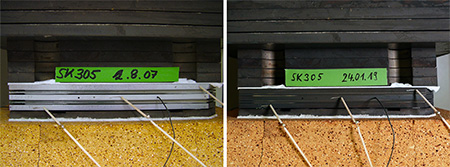They waited for a lifetime of 100,000 hours to be achieved before gradually bringing their lifetime test to a close a few days ago: researchers from Forschungszentrum Jülich developed a fuel cell and operated it at a temperature of 700 °C for more than 11 years. During its lifetime, this high-temperature fuel cell produced electricity for more than 10.5 years – longer than any other high-temperature fuel cell so far. Demonstrating such a long lifetime is viewed as an important step in the development of high-temperature fuel cells designed for maximum efficiency.
“In the beginning, no one thought that it would be possible to operate a high-temperature fuel cell over such a long period of time,” explains Prof. Ludger Blum from Jülich’s Institute of Energy and Climate Research (IEK-3). “This extremely successful test has now shown that the version of this fuel cell type developed at Jülich brought us much closer to application maturity,” says Blum, who has monitored the long-term experiment since the beginning.
Ceramic high-temperature fuel cells achieve the highest efficiencies and are considered particularly low-maintenance. However, the high operating temperature also poses great challenges for the materials used. Potential applications include a local electricity and heat supply for households, larger residential areas, or industry, as well as systems for trains or ships. Such high-temperature fuel cells would have to operate for 5–10 years, or 40,000–80,000 hours, in order to make the application economically viable.
Jülich’s solid oxide fuel cell (SOFC) kept running for much longer than that. The long-term experiment was the first in the world to demonstrate a lifetime of 100,000 hours. Since the experiment began on 6 August 2007, the cell stack consisting of two cells continuously produced electricity for over 93,000 hours, a total of approximately 4,600 kWh. This corresponds to the amount of power that a single-family household uses in one year.
Switching off the SOFC involves new tasks for the researchers. The metallic components have visibly changed over the years. The metallic, silvery, shiny surface has darkened considerably; it is almost black. Apart from this almost unavoidable surface oxidation, no negative changes are visible from the outside.
“We are all eager to see what it looks like on the inside,” says Dr. Norbert Menzler from the Institute of Energy and Climate Research (IEK-1), who heads the development of these ceramic cells. “The state of the cell cannot be determined during operation. So far, no one has been able to examine a cell after 100,000 hours of operation at such high temperatures.”
Over the coming weeks and months, the researchers will use various methods to analyse exactly how the extreme thermal load over years has affected the ceramic components, glass sealants, and metallic interconnects. These insights will contribute to the development of new materials and design concepts in order to continually improve ageing resistance.
The team of scientists headed by Ludger Blum are currently testing a version of the SOFC that can be operated in reverse. It not only generates electricity but in reverse mode of operation, it can also produce hydrogen and oxygen from water electrolysis. This further development has also already achieved very good initial results. It is the first high-temperature fuel cell to achieve an efficiency of more than 60 % in hydrogen operation at 62 %.























